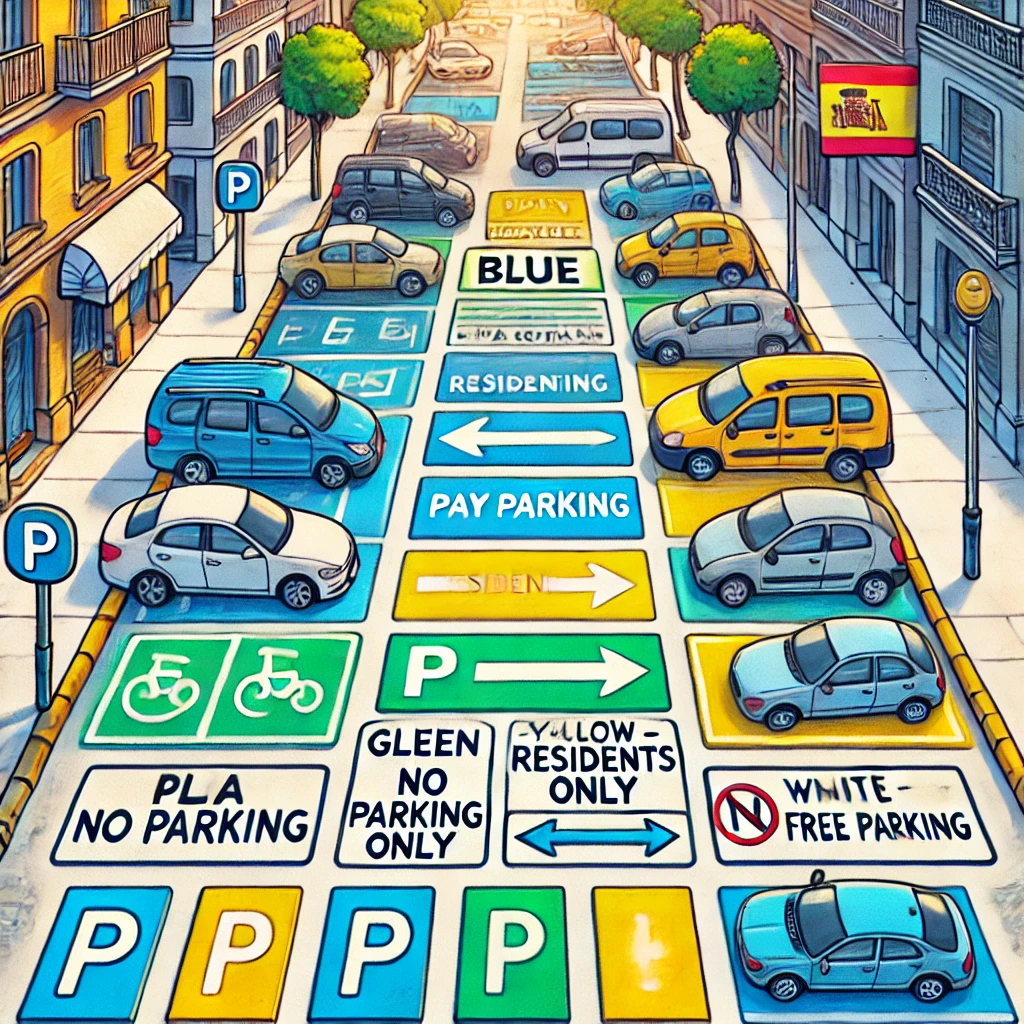Parking in Spain: an art in itself
Parking in Spain: an art in itself
Parking in Spain: an art in itself
Parking in Spain: an art in itself
9. November 2024
Feedback: 0
Parking in Spain can be an interesting experience, especially in major cities like Madrid, Barcelona, or Valencia. One of the first things you’ll notice are the differently colored parking markings, each with its own specific meaning. Without knowing these, you risk stress, fines, or even having your car towed. Parking in Spain can quickly become challenging if you’re not familiar with local rules—but don’t worry, I’m here to guide you through the Spanish parking regulations!
Parking in the City: Where Are You Allowed to Park?
Let’s start with the basics: Parking in Spanish cities can be tricky. The colored street markings—blue, green, and yellow zones—show you where you can park and where you should move along. These zones are found in almost every town and village and make parking easier when you know what they mean.
1. Blue Zone – Okay to Park, but Not Free (“Zona Azul”)
The blue zone is probably the most common parking area in Spain and the one you’ll likely encounter most often in bigger cities. It’s designated for paid parking, especially in city centers, to ensure spots aren’t blocked by the same car for hours. In short: you can park here, but it costs money and there’s a time limit.
◉ Time Limit: The limit varies, but generally, you can park for between one to four hours depending on your location. In smaller towns, it might be two hours; in big cities like Barcelona, it’s often just one hour.
◉ Cost: Rates vary from city to city, but you can expect around 1 to 3 euros per hour. Fees usually apply Monday to Friday during daytime hours, often from 9:00 a.m. to 2:00 p.m. and again from 4:00 p.m. to 8:00 p.m. Some cities also charge on Saturdays, while Sundays are often free.
◉ Payment: Payments are made at nearby parking meters. Many cities now offer apps so you can easily extend your parking time.
💡 Tip 💡
Don’t forget to place your ticket visibly on the dashboard. Otherwise, you might get towed before you can say „multa“ (fine).
2. Green Zone – Residents First! (“Zona Verde”)
The green zone is mainly reserved for residents with a special parking permit. Although you can park here as a visitor, it’s often more expensive and time-restricted. With residents given priority, it can be tough to find an available spot.
◉ Resident Zone: In most cases, residents can park here for free or at a significantly reduced rate. This makes parking in city neighborhoods much easier for those who live in town.
◉ Visitor Parking: In many cities, visitors are also allowed to park in the green zone but at a higher rate than residents. Time limits similar to the blue zone often apply, though exact conditions vary by city.
3. Yellow Zone – Don’t Even Think About It! (“Zona Amarilla”)
Yellow zones nearly always mean one thing: no parking allowed! You’ll find these markings in areas where parking would be dangerous or obstructive, like at curves, narrow streets, near bus stops, or emergency exits.
◉ Solid Yellow Line: This is the strictest indicator, meaning you absolutely cannot park here. Ignoring this risks both a fine and a high likelihood that your car will be towed.
◉ Broken Yellow Line: This sometimes allows parking within certain timeframes, but it usually still means no parking. Always read nearby signs to be sure.
If you park in a yellow zone and your car gets towed, you’ll need to retrieve it from an impound lot, which can be costly and challenging—especially if you don’t speak Spanish and have to navigate the city to find your car!
4. White Zone (“Zona Blanca”)
Ah, the white zone—the rare but highly sought-after parking area in Spain. These zones indicate free parking, and they’re a blessing, especially in crowded urban areas. But beware: not all white-marked areas are actually for parking.
◉ Public Parking: In smaller towns and rural areas, white parking zones are relatively common. You can park here for free with no time restrictions.
◉ Restrictions: In larger cities, these are rare, and if you do find one, check the signage carefully. Sometimes there are hours when parking is allowed and others when it’s prohibited.
Since white parking areas are so coveted, remember they tend to fill up quickly—especially in popular tourist zones.
5. Sidewalk Parking
In small towns or narrow streets, you may see people casually parking on the sidewalk. While this might be common among locals, as a tourist, it’s best to avoid it. In most cities, parking on sidewalks is illegal unless explicitly permitted.
Parking in Major Cities
Rules can vary among Spanish cities, but generally, in Spain’s largest cities like Madrid, Barcelona, and Valencia, parking regulations are strictly enforced. These cities often have additional zones, such as red-marked areas reserved for delivery vehicles or designated areas for electric cars.
In major cities, it’s often easiest to use a parking garage. While not always the cheapest option, garages save you the hassle of searching for a spot on the street and worrying about time limits or fines.
Parking in Rural Areas – More Space but Still Rules
Outside the city, parking tends to be more relaxed, though there are still a few things to keep in mind.
Roadside Parking – Usually Okay
In rural areas, parking along the roadside is generally acceptable, especially on less busy roads. However, be cautious as roads can be quite narrow—you don’t want your car to become part of the scenery!
Parking on Private Property – Best to Avoid Without Permission
While parking near scenic areas may be tempting, make sure you’re not on private property. Spaniards are easy-going, but they take property rights seriously.
Parking Garages – Safe Haven for Your Car
If you’re in a larger city and don’t want the stress of finding a street spot, parking garages are a safe option. They’re secure, typically centrally located, and free you from worrying about blue or green lines.
Note: Spaces in Spanish garages tend to be snug, so be prepared for some acrobatics when getting in and out!
Tips for Parking in Spain
To stay on the safe side and avoid fines or worse, here are some tips for parking in Spain:
◉ Read the signs: It sounds simple, but signs provide essential info on parking times, fees, and restrictions.
◉ Use payment apps: In many cities, you can pay and extend your parking time through an app, saving you a trip back to the meter.
◉ Don’t park on a whim: If you’re unsure whether you can park somewhere, don’t risk it. Fines for illegal parking can be hefty.
◉ Use parking garages: Especially in big cities, garages can be a stress-free alternative to street parking.
◉ Watch for e-scooter and bike zones: Many Spanish cities have designated parking spaces for electric scooters and bikes—don’t park in these areas.
Final Thoughts
Parking in Spain is simple enough if you understand the color-coded markings and pay attention to signs. Use blue and green zones correctly, avoid yellow, and you’ll be set for a smooth visit. Sure, parking in Spain can be adventurous, but with some practice, you’ll soon get the hang of it. Whether in the city, countryside, or a parking garage, there’s always a solution. And if things go awry, at least you’ll have a story to tell!
We hope these tips will help you to master your everyday life as an expat even better! Do you have your own experiences or further recommendations on the topic of emigrating? Feel free to leave us a comment! Share this post with others who could benefit from the tips and stay tuned for more inspiration from life as an expat.
Your Steffi & Marius

Wir sind zwei deutsche Auswanderer und auf emigres-life nehmen wir Dich mit auf unsere Reise in ein neues Leben.
In unserem Projekt schwingt das Pendel meist in Richtung stressig oder chaotisch und weniger in Richtung tiefenentspannt.
Wenn du also wissen willst, in welches Fettnäpfchen wir als nächstes treten oder welche Hürden vor uns liegen und wie wir sie überwinden, dann bleib dran.
Nächster Blogpost
Winterflucht nach Spanien – 6 Gründe für Körper & Seele


 Pin it!
Pin it!

